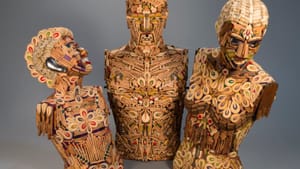Stay in the Loop
BSR publishes on a weekly schedule, with an email newsletter every Wednesday and Thursday morning. There’s no paywall, and subscribing is always free.
Heady stuff at the American Visionary Art Museum
Human, Soul and Machine: The Coming Singularity

Human, Soul & Machine: The Coming Singularity! is the provocative title of the current featured exhibit at Baltimore’s American Visionary Art Museum (AVAM). The exhibit is perhaps the 19-year-old museum’s most ambitious one yet, for it grapples with arguably the biggest issues in the world today: the rapid pace of technological advancement and technology’s incursion into virtually every aspect of our lives.
AVAM’s mission is unique in the art world: It showcases only the work of artists who have had no formal artistic training. The museum takes a correspondingly informal approach to exhibit design; there’s rarely explanatory wall text to guide you through an exhibit, only biographical information about the artists. This approach makes the complex Singularity exhibit, in particular, challenging to absorb.
Fortunately, AVAM founder and director Rebecca Alban Hoffberger — who also curated this exhibit — has composed one panel of wall text that eloquently contextualizes the show.
“We investigate technology’s impact on personal privacy and surveillance, employment and manufacturing, longevity and health, defense and warfare, farming and food, creative invention and entertainment,” she writes. “This is high stakes, new territory never before negotiated by any prior civilization. We want everybody to be awake and present at the table as these great new powers . . . unfold and alter life on earth.”
After that, you’re on your own; there are no other contextual cues or clues. In many ways, this is a good thing. After all, aren’t we all navigating on our own through an increasingly high-tech maze every day?
Finding your way
I decide to start by walking up the winding staircase to the second floor, where the main part of the exhibit is located. It’s a bit of a dizzying walk up, so I linger to read the many quotes by leading technological innovators and philosophers that are mounted on the wall. One in particular, by the late astronomer Carl Sagan, gives me pause: “We’ve arranged a civilization in which most crucial elements profoundly depend on science and technology. We have also arranged things so that almost no one understands science and technology. This is a prescription for disaster.”
By the time I’ve reached the top of the staircase and read nearly two dozen provocative quotes, I feel a mounting sense of anxiety: Are we the masters of our technology, or is technology dwarfing our humanity?
I hope this exhibit will help me answer, or at least give me insight into, this question. But I can’t even figure out where the exhibit begins. Am I missing something? I turn and look down at the wall by the staircase I’ve just climbed. To my surprise, I see that above the quotes I’ve read is a graph — gorgeously rendered in brightly colored swaths of cloth — that illustrates how the U.S. government chooses to spend our tax dollars. The graph, based on research conducted by the nonprofit National Priorities Project, depicts how the U.S. government spent its 1.15 trillion discretionary tax dollars in 2013. The vast majority of those dollars — a whopping 57 percent — went to support the military, while only 6 percent was spent on education and 3 percent on science. A paltry 1 percent was spent on agriculture.
It’s a powerful graph. Is it, I wonder, part of the Singularity exhibit? I briefly look around for a staff member to answer this question, can’t find anyone, then decide the answer probably doesn’t matter. The whole point of a visit to AVAM is to wander and wonder, to formulate your own questions and answers.
"The Singularity Is Near"
Across the hall, a film is showing. A gorgeous young woman with pink hair and weird, luminous green eyes is talking. She’s wearing a sexy spandex outfit that reminds me of the outfits female Starfleet officers wore in the original Star Trek TV series. I find this amusing, so I decide to take a seat. Turns out she’s a robot with artificial intelligence — an “AI” for short — and she’s suing for the right to be considered a human. It’s a hilariously strange digression in an otherwise deeply engrossing documentary called The Singularity Is Near, about the ideas of Ray Kurzweil, whose best-selling 2005 book of the same name is partly the inspiration for this exhibit.
It’s a long film for a museum exhibit, 75 minutes, and, strangely, the running time isn’t posted anywhere. Still, I’d recommend watching at least the first half of the film, because in it, Kurzweil cogently explains what he calls “the law of accelerating returns” — that technology is changing so fast, we’ll need to enhance our intelligence to cope with it. By 2045, says Kurzweil, humankind will experience a “technological singularity”: a point at which technology has progressed beyond people’s ability to comprehend it.
Kurzweil notes that artificial intelligence is not something that will arrive in the distant future; it’s already here, at our fingertips, in the form of computer search engines like Google.
He also notes that our genes are essentially software programs and that technologies being developed now will allow certain genes to be turned off and new genes added, essentially reprogramming biological processes “away from disease, away from aging.”
It’s heady stuff, and I feel the need to wander away from the film in search of art that may help ground me. I’m drawn to “Ajax,” a metal figure made from found objects, a player piano, and LEDS. Interestingly, artist Alan Christian, an electrician by training, has created an opening in the metallic “skin” of the figure where the stomach of a human would be, and he’s rigged an electronic churning system — a reference, no doubt, to the way our own digestive systems churn. It’s an intriguing reminder that the human body is arguably the greatest technological system of all.
Seeking humanity
“Ajax” is surrounded by several imposing paintings by visionary artist Alex Grey, which depict psychic and spiritual energy fields radiating in and around the human body. Grey’s works strike me as beautiful but a bit blank, so I head off again in search of art that feels more humane, more humble. I quickly find what I’m searching for in a gallery largely devoted to the tender wood carvings and haunting oil paintings of Fred J. Carter.
 Exceptionally moving are Carter’s white walnut carving of a frail, elderly man reaching toward the sky called “Quo Vadis,” and a sculpture of a pregnant woman called “Behold My Miracle” (referring to his second wife, Vickie, who gave birth to Carter’s first biological child when he was 72). Equally moving is “The Last Walk,” an oil painting of an old man walking with a cane down a dark wooded path.
Exceptionally moving are Carter’s white walnut carving of a frail, elderly man reaching toward the sky called “Quo Vadis,” and a sculpture of a pregnant woman called “Behold My Miracle” (referring to his second wife, Vickie, who gave birth to Carter’s first biological child when he was 72). Equally moving is “The Last Walk,” an oil painting of an old man walking with a cane down a dark wooded path.
An ardent environmentalist who’s worried that our planet is in peril, Carter is as articulate with words as he is with wood and oils. “We are all living creatures . . . connected from the time we are all stardust,” he is quoted as saying. “I’m no mystic . . . I wouldn’t call myself a Hindu or a Zen Buddhist or a believer in anything. Except I’m a believer in everything.”
The exhibit also includes a wide range of other art and craft pieces, including paintings of lucid dreams and a big, black-box installation called “Robolights” by Kenny Irwin Jr.; Adam Kurtzman’s full-sized “Elsa Lanchester as Bride of Frankenstein”; and real bugs with mechanical enhancements crafted by Lindsey Bessanson. In addition, there is a set of enchanting drawings by Chris Roberts-Antieau called “The Story of Invention,” in which the artist uses the Greek myth of Prometheus to lament how humankind uses the gifts of Earth — in this case, fire — to wreak havoc upon the planet.
Although I didn't leave this show feeling more enlightened on the topic of how technology affects our lives, I did feel as I always do after a visit to AVAM: glad that this quirky museum is here, posing provocative questions — even if those questions defy answers.
Above right: Fred Carter, "Behold My Miracle," 1983, Carved wood, Collection of Mary Carter Owens and Vel-Holly Fleming. Photo by Dan Meyers, courtesy of AVAM.
What, When, Where
Human, Soul & Machine: The Coming Singularity! through August 31, 2014. American Visionary Art Museum, 800 Key Highway, Baltimore, Maryland. 410-244-1900 or www.avam.org.
Sign up for our newsletter
All of the week's new articles, all in one place. Sign up for the free weekly BSR newsletters, and don't miss a conversation.

 Marilyn Millstone
Marilyn Millstone